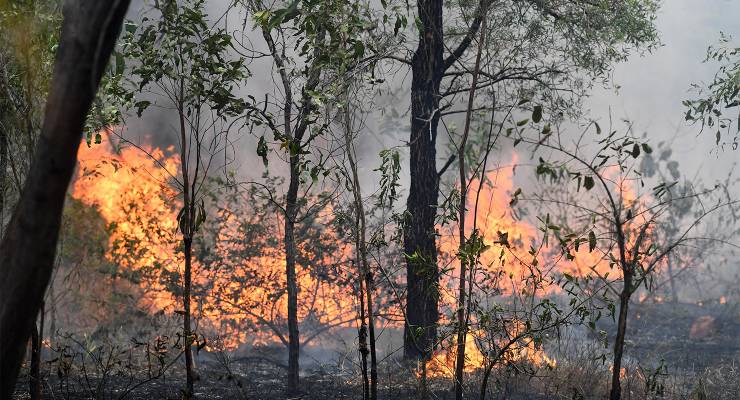
Even the most progressive Australians often regard “listening to Country” as a cultural metaphor rather than a rigorous method to learn empirical truths. But as Gamilaroi woman and educator Lee Couch advised me in 2020, the year of the Black Summer bushfires: “Half of Country was on fire this year. There’s no better time to listen to Country than now.”
If you can’t listen to Country, listen to expert women attuned to the land and you’ll hear how a certain white masculinity is inscribed into Australia’s landscapes. Social geographer Christine Eriksen’s studies are among those finding bushfire “is not a gender-neutral natural phenomenon” but a “means by which traditional gender roles and power relations are maintained”.
This happens in many ways. Climate change is worsening bushfire severity and intensity, and a raft of recent books — most notably, Mary Robinson’s Climate Justice — explain how global warming is a man-made problem with feminist solutions. A product of colonisation, the climate crisis was generated by generations of men who occupy positions of power in governments and industry.
Humans deliberately or accidentally ignite 85% of Australia’s bushfires — 90% of these are lit by men. The Australian Institute of Criminology suggests the arsonist profile is “white male, mid-20s, patchy employment record … and poor social development”.
Different genders and ethnicities have very dissimilar ways of responding to crises, yet state bushfire responses remain commandeered by predominantly white men, and fire bureaucracies remain oriented towards masculinist colonial worldviews. Within these agencies, cultures of sexism thrive, making it hard for women to express their knowledge at best capacity.
Contrary to First Nations understandings, southern states’ bushfire policies regard landscape as a threat and fire as a weapon. Consequently their responses deploy crude and militaristic approaches and scientifically debunked methods such as broadscale forest burning for “fuel load reduction”, repeatedly shown to increase longer-term flammability.
“You can’t fight fire with fire. You have to work with it,” advises the Indigenous-led Firesticks Alliance researcher Dr Peta-Marie Standley. A body of studies show incendiary burns by fire agencies frequently worsen longer-term forest fire risk by promoting flammable woody regrowth, removing moist self-thinning mid-storeys and drying forest floors.
Having made forests more flammable, state agencies have also begun to enlist Indigenous cultural burning practices — or “cool burns” — for bushfire “hazard reduction”. A Wurundjeri uncle in my local landcare group was among the men sent to Cape York as part of a $22.5 million grants program to train Indigenous Victorians in cultural burning. He described the state’s subsequent misappropriation of his knowledge. Anthropologists, too, have documented ways these practices are co-opted by southern state agencies and reduced to fit narrow “fuel reduction” narratives and agendas.
State-funded “traditional” fire practitioners also remain predominantly male — regardless of whether they burn on women’s Country, whether ecosystem stewardship is traditionally women’s business, or whether cultural burns are known traditions in the region. Cultural burns have nuanced, complex specificities — to place, to lore, to knowledge, to cosmology and to climate.
Ecologist Dr Rosemary Hill, who studied Kuku-Yalanji burns in far north Queensland, says they are “extraordinarily fine-scale management … highly consistent with protection of biodiversity” — and so can’t be copied wholesale from one landscape to another, nor reduced to a set of procedures.
Australia’s bushfire responses increasingly fit Naomi Klein’s “disaster capitalism” model, in which reactive “contractors move in and suck up funding for work done badly”. In the Gulf of Carpentaria, Waanyi and Garawa women’s fire practice is known to mitigate bushfires — yet it’s underfunded and poorly understood. “There’s not a lot of literature on women’s traditional roles in fire management, maybe because researchers are generally male and it’s hard for them to hear women’s stories,” explains PhD researcher Kate van Wezel.
Rematriation approaches include pro-forestation, caring for soils and waterways, cultivating circular economies and healing social disadvantage in rural fringe communities where most bushfires are ignited. Social and environment resilience researcher Associate Professor Janet Stanley is among experts explaining how social disadvantage worsens bushfire risks and how policy can “reduce both social injustices and the occurrence of bushfires”. Some women, such as Associate Professor Marta Yebra, have invented satellite and drone systems that could “detect bushfires early and put them out within minutes”.
Expert women say we need to redress a lethal imbalance. Rematriating involves “looking at the land like a mother or a family member”, says Budawang researcher Sian Hromek, a Firesticks Alliance director, in a recent interview. Country, she explains, “is our life force. This is where we’ve come from and where we’re going back to, so we treat it like a relationship. We’re the ones who need to lead this, and link arms with government … If Indigenous people aren’t leading, then you aren’t learning … The social implications are really important.”
Expert women say Australia can’t address its bushfire crises using the very structures and mindsets that enabled them. First Nations and non-Indigenous women can’t heal Country using the systems whose impacts they seek to repair, and Australia won’t prevent megafires while excluding more than half its citizenry.
Is it time to let the experts, Indigenous women, teach us how to fight fire? Let us know by writing to letters@crikey.com.au. Please include your full name to be considered for publication. We reserve the right to edit for length and clarity.








So what’s going on with Rundle then? Any updates?
The person who wrote the U of Melbourne article, Dr Janet Stanley, which contained the 85% figure, did not provide a source. She just said “experts” stated it.
Well, that’s doubtful.
I recall a study of bushfire sources in 2020 which said most of the 2019 fires had natural causes, like lightning strikes.
Can’t find the source right now, unfortunately, but she definitely didn’t have one.
I remember that controversy. Dutton (who else?) refused to say that the fires had anything to do with climate change; he said they started because “someone lit a match.’ The ABC Fact Check found the situation is complex:
https://www.abc.net.au/news/2020-01-15/is-arson-mostly-to-blame-for-the-bushfire-crisis/11865724
Dutton and News Corpse. Wonder how they’re accounting for the northern hemisphere fires right now?
According to the Australian Institute of Criminology: “natural fires account for only six percent of known causes of vegetation fires attended by fire services. Over 90 percent are the result of people’s actions, and more often than not the result of deliberate ignitions” https://www.aic.gov.au/sites/default/files/2020-05/tandi350.pdf
Many researchers, too, peg the figure at 90 per cent rather than 85 per cent, one of the more conservative figures. This news article pegs it at 87 per cent: https://www.smh.com.au/national/arson-mischief-and-recklessness-87-per-cent-of-fires-are-man-made-20191117-p53bcl.html
Fires close to cities/towns would be mostly people, out in the boondocks they would be nearly all natural, imo. Fuel reduction, from what I’ve seen, the more they burn the more they have to burn, as the article says, “Increases long term flammability”. That’s in the WA jarrah forest anyway. Selective logging leaves very large amounts of fuel behind. Historic logging took all the big trees, followed later by anything remotely useful. The stumps then sprout multi new trunks and the devastated forest, which looks OK if you don’t know the difference, gets made a National Park. The long term drying (20%) has made burn opportunities too short to carry out the ‘program’ set by scientists, so it”s all a bit of a basket case. French explorers, the first Europeans to see the forest, described it in detail (it was awesome, apparently) and today it has completely changed. And much has been cleared for farming of course. I don’t know that the French described any burning in the wet forest. With Arctic forests burning it’s hard to see ours surviving long term.
Sorry if I’m off topic.
Hey, we cut down the world’s tallest tree, how about that!
We in the forested regions have long called the department of many name changes “the department of sparks and embers” because of the disastrous results from careless lighting of fires in adverse conditions that were actually forecast. Gosh this link was an eye opener.
https://overland.org.au/previous-issues/issue-234/featurethe-fire-cult/
Having said that, I’m sure there’s many good people in the department itself that have protested or tried to protest those kind of burns. May the good fairy of the public service promote these folk to positions of power within their departments.
A very confused argument on Wilsons’s part.
I was a volunteer bush fire fighter in W.A. some years ago for a fair length of time. back then we used the “cool burn” method of hazard reduction frequently. Lots of small fires started by the fireies at about 2 meter intervals, each fire ran into the adjoining burnt patch and died out. Backup was provided to prevent flare ups by other Fireies.
Under suitable conditions hotter “Line burns” were used. Nothing new about this and is plain old common sense as was used by the aboriginal population, where suitable.
However as has been noted, many things, climate, forest composition, understory Etc. have changed/ been altered. Old methods where applicable and new methods for the different circumstances of today need to be used or developed.
Harping on about Colonialism and “old Whites” and “men” is stupid and unproductive, as is conflating Feminism with bushfires.
In the Brigade I was in we had six female members one of whom was Captain. They had views which were listened to and where appropriate acted on by all members. A big problem was attracting Vollies and especially female ones. Most members wives , though invited would not have a bar of it.
So how about it Katherine, are you ready to sign up and work your way up to the top where you can organise events?
Bring your mates along too, you will be welcome, but not if you start mouthing off before learning anything
You’re presuming I’ve never been in the CFA nor had any experience with it. Many CFA women in my community have very different experiences from the women you claim to speak for. See the studies hyperlinked in the article.
Also, you say “common sense” says certain methods work. Scientific studies, some of which are hyperlinked above, show they haven’t. “Common sense” says to heed the rigorous research that shows in certain forested areas, planned burns merely decrease short-term risk, but increase longer-term risk.
I don’t claim to speak for the women in my old brigade, I described the situation that existed.
Certainly some teasing and jokes were probably made on occasion, we had a lot of fun and laughs,but I can’t recall any malice between different sexes, and no restrictions on female members moving up through the ranks.
I do presume that you haven’t been in the CFA or Bushfire Brigade.
I did say that situations had changed and that different methods need to be tried.
I only see sillyness in using sexist, ageist and skin colour as a reason for anything hindering change in this day and age. Way back when, it was common, but wallowing in the past and remaining dregs is unproductive
Yeah, what’s going on with Rundle?